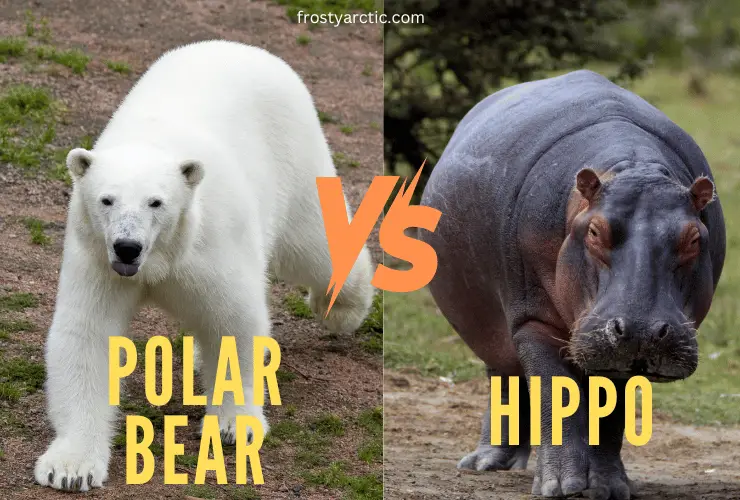Polar bears and hippos, while both are sizable mammals, display a world of difference.
Polar bears are marine mammals with white fur, a carnivorous diet, and a solitary lifestyle. They have large paws and sharp claws for hunting seals and navigating icy terrains. Conversely, hippos are semi-aquatic herbivores with massive bodies, nearly hairless skin, and social nature. They are known for their intimidating jaws and spend most of their time in freshwater bodies to keep cool.
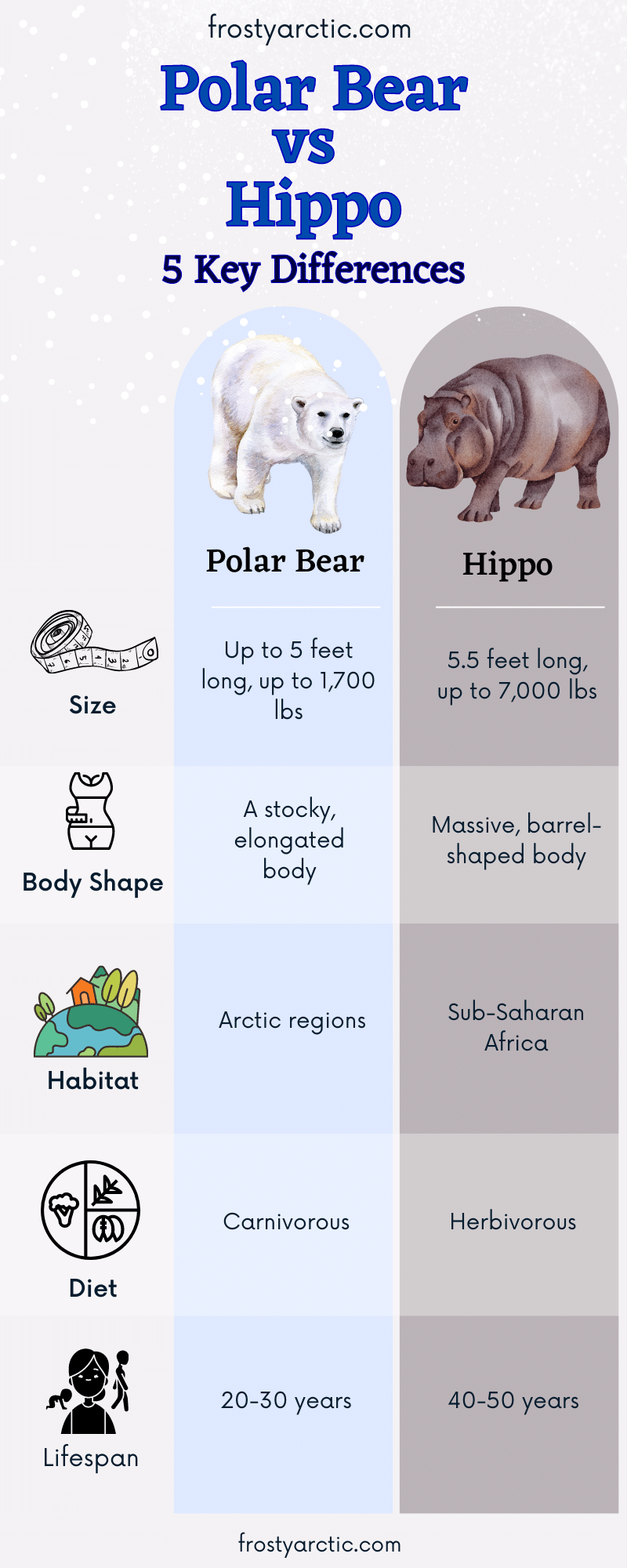
Ever wondered how the daily life of a polar bear in the chilling Arctic compares to that of a hippo basking in the African sun? It’s quite the contrast, isn’t it? This remarkable disparity is a beautiful demonstration of Earth’s awe-inspiring biodiversity.
Ready to uncover more? We’re just getting started! Continue reading to uncover the intriguing differences between polar bears and hippos. The adventure is just beginning!
Polar Bear vs Hippo – A Quick Comparison
| Feature | Polar Bear | Hippo |
| Scientific Name | Ursus maritimus | Hippopotamus amphibius |
| Family | Ursidae | Hippopotamidae |
| Body Shape | A stocky, elongated body | Massive, barrel-shaped body |
| Size | Up to 5 feet long, up to 1,700 lbs | 5.5 feet long, up to 7,000 lbs |
| Diet | Carnivorous | Herbivorous |
| Habitat | Arctic regions | Sub-Saharan Africa |
| Social Behavior | Mostly solitary | Live in groups called pods |
| Lifespan | 20-30 years | 40-50 years |
| Gestation Period | Approximately 8 months | Around 8 months |
| IUCN Status | Vulnerable | Vulnerable |
Polar Bear vs Hippo – What Are the Key Differences?
While inhabiting completely different corners of the Earth, polar bears and hippos share some intriguing similarities.
As adults, they are both largely free from predation due to their impressive size and strength. Additionally, they’re both known to be excellent swimmers and spend a good amount of time in the water.
However, the commonalities don’t extend much further. As we journey from the Arctic to the African plains, we’ll discover many differences between these two captivating species. So, let’s dive in and explore these differences!
1. Taxonomy and Scientific Classification
Though they are both mammals, the polar bear and the hippopotamus are worlds apart in their taxonomic classification.
Polar Bear
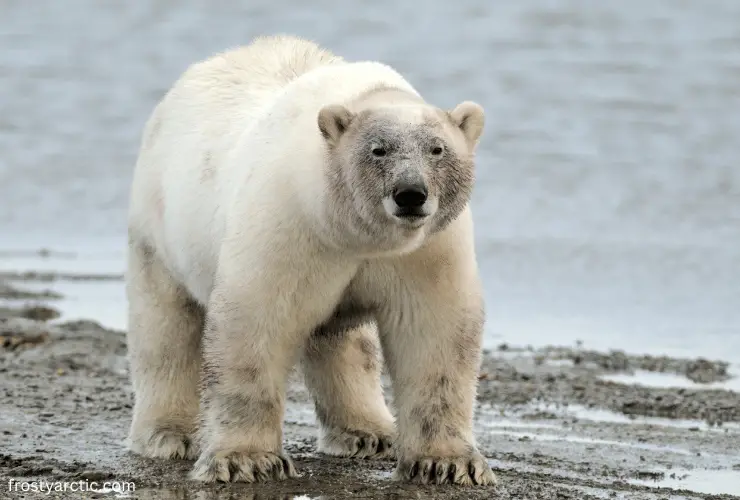
The polar bear, known as the maritime bear, is scientifically called Ursus maritimus.
It belongs to the Ursidae family, which encompasses all bear species. It is classified as a distinct species in the genus Ursus. Polar bears fall under the Carnivora order due to their meat-eating diet.
Scientifically speaking, polar bears are closely related to brown bears, having diverged from them around 500,000 to 600,000 years ago.
Hippo

The common hippopotamus, or simply the hippo, is scientifically known as Hippopotamus amphibius.
Hippos belong to the Hippopotamidae family, which includes only two extant species: the common hippo and the pygmy hippo.
They’re part of the Artiodactyla order, encompassing even-toed ungulates. Their name means “river horse” in Greek.
| Taxon | Polar Bear | Hippo |
| Kingdom | Animalia | Animalia |
| Phylum | Chordata | Chordata |
| Class | Mammalia | Mammalia |
| Order | Carnivora | Artiodactyla |
| Family | Ursidae | Hippopotamidae |
| Genus | Ursus | Hippopotamus |
| Species | Ursus maritimus | Hippopotamus amphibius |
2. Habitat and Distribution
Though the earth is their shared home, the polar bear and the hippopotamus live in extremely contrasting habitats.
Polar Bear
Polar bears are the icons of the Far North, adapted supremely well to life in the Arctic. Here’s a snapshot of their habitat:
- Continent: Primarily North America, with some populations in Europe and Asia.
- Countries: Canada (the majority of the population), Greenland, Norway, Russia, and the United States (Alaska).
- Habitat: Sea ice environments in the circumpolar Arctic.
Polar bears rely extensively on sea ice as a platform to hunt seals, their primary food source. Their habitat has a cold climate with temperatures that can drop below -40 degrees Fahrenheit. ~World Wildlife Fund
Hippo
Contrastingly, hippos are lovers of heat and water. These semi-aquatic mammals are found in:
- Continent: Africa
- Countries: Sub-Saharan African countries, including Zambia, Tanzania, South Africa, Mozambique, and Kenya.
- Habitat: Rivers, lakes, and swamps in grasslands and forests.
Hippos spend much of their daytime in the water to keep their large bodies chill under the African sun. At night, they venture onto land to graze on grass. Hippos require access to both land and water, as they are adept at living in both environments. ~World Wildlife Fund
| Attribute | Polar Bear | Hippo |
| Continent | Primarily North America | Africa |
| Countries | Canada, Greenland, Norway, Russia, USA (Alaska) | Zambia, Tanzania, South Africa, Mozambique, Kenya, etc. |
| Habitat | Sea ice environments in the circumpolar Arctic | Rivers, lakes, and swamps in grasslands and forests |
3. Physical Appearance
Though both are large and imposing creatures, the polar bear and the hippopotamus have drastically different physical attributes that reflect their unique environments and lifestyles.
Polar Bear
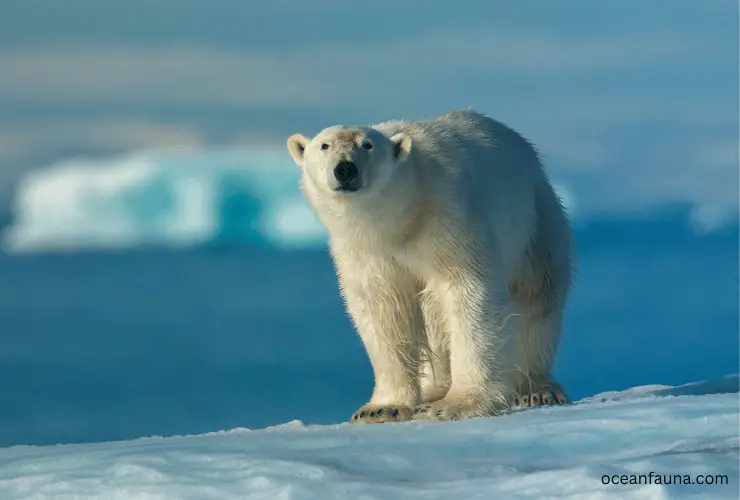
- Color: Polar bears are mostly white, blending with the ice and snow.
- Weight: Males typically weigh between 550 and 1,700 lbs, while females are smaller, ranging from 330 to 650 lbs.
- Height: When standing on all fours, they’re about 3.3 to 5 feet at the shoulder. On hind legs, they can measure up to 11 feet.
- Body Features: They have a longer neck and smaller head compared to other bears, which aids in seal hunting. Their bodies are elongated, and they have large, paddle-like paws for swimming.
- Their dense fur and a layer of blubber up to 4.5 inches thick help insulate them from the cold. The fur isn’t actually white—it is translucent and looks white as it reflects light.
Hippo

Color: Hippos have grayish-brown skin, which secretes a red-colored natural sunscreen, leading to the myth that hippos sweat blood.
- Weight: Hippos are significantly heavier than polar bears. Adult males can weigh between 3,310 and 7,000 pounds. Females are smaller, weighing around 3,300 pounds.
- Height: They stand about 4.5 to 5.5 feet tall at the shoulder.
- Body Features: Hippos have a large barrel-shaped body, a huge mouth capable of opening up to 150 degrees, and tusks that can grow up to 20 inches long.
- A hippo’s skin is nearly hairless and very sensitive to the sun. To prevent sunburn, their skin secretes a pinkish oily substance known as “blood sweat” or “hippo sweat.” ~Animal Diversity
| Attribute | Polar Bear | Hippo |
| Color | White | Grayish-brown |
| Weight | 550-1,700 lbs (male), 330-650 lbs (female) | 3,310-7,000 lbs (male), 3,300 lbs (female) |
| Height | 3.5-5 feet at the shoulder, up to 11 feet standing | 4.5-5.5 feet at shoulder |
| Body Features | Long neck, small head, paddle-like paws, thick fur, and blubber | Barrel-shaped body, huge mouth, long tusks, nearly hairless |
4. Diet and Feeding Habits
Just as polar bears and hippos live in different habitats, they also have very different diets and feeding habits that are specifically adapted to their respective environments.
Polar Bear
The polar bear is a top predator in its Arctic home and is well-known for its primarily carnivorous diet.
- Diet: Their diet mainly comprises seals, specifically ringed and bearded seals.
- Feeding Habits: Polar bears are excellent swimmers and hunters. They use a ‘still hunting’ technique where they wait by a seal’s breathing hole in the ice, and when the seal surfaces, the bear will strike.
They are capable of fasting for months during the late spring and summer when they cannot access sea ice, relying on their stored fat for energy.
Hippo
On the other hand, despite their massive size and carnivorous-looking teeth, hippos are primarily herbivorous.
- Diet: They mostly eat grass, reeds, small shoots, aquatic plants, and fallen fruit.
- Feeding Habits: Hippos are nocturnal feeders. They leave the water at night and may travel several kilometers to graze, consuming up to 110 pounds of grass in a single night. ~National Geographic
Although hippos are known to eat meat and carrion, these incidents are unusual. They are often a result of nutritional stress or disturbed habitat conditions.
| Attribute | Polar Bear | Hippo |
| Diet | Primarily carnivorous (especially seals) | Primarily herbivorous (especially grasses) |
| Feeding Habits | Still hunting technique, capable of long fasts | Nocturnal grazers, occasional scavengers |
5. Social Behavior
Both these species exhibit unique social behaviors that are adapted to their respective environments.
Polar Bear
- Social Structure: Most polar bears are solitary and have a large home range, with males’ territories often overlapping several females’. However, they aren’t territorial and have been observed to tolerate each other in places where food is abundant, like a whale carcass.
- Interactions: While they are generally solitary, they can also be quite social. Non-breeding polar bears will sometimes form friendships and play-fight together.
- Mating Behavior: During mating season, males follow the scent trails of breeding females for miles. After mating, the pair separates, and the female raises her cubs alone. ~Source
Hippo
- Social Structure: Hippos live in groups called ‘pods,’ ‘herds,’ ‘dales,’ or ‘bloats,’ which typically contain 10 to 30 individuals but can contain hundreds.
- Interactions: The group is often led by a dominant male who defends the territory. The dominant male marks his territory by throwing his dung as far as he can with its fan-shaped tail!
- When two rival males encounter each other, they engage in a remarkable display called “gaping.” They face each other, nose to nose, and open their mouths as wide as possible. More often than not, the smaller male retreats. Fights for dominance can be fierce and are often accompanied by loud vocalizations.
- Mating Behavior: Only dominant males have the right to mate with the females in their group. Females will leave the group to give birth, returning with the calf after a few weeks. ~Sandiegozoo.org
| Attribute | Polar Bear | Hippo |
| Social Structure | Generally solitary, large home range | Live in groups called ‘pods’ or ‘herds.’ |
| Interactions | Can form friendships and play-fight, especially outside of breeding season. | Led by a dominant male, fights for dominance can be fierce |
| Mating Behavior | Males follow the scent trails of breeding females. Females raise cubs alone. | Only dominant males mate with females. Females leave the group to give birth |
6. Reproduction and Lifecycle
How each species reproduces and raises young can tell us much about its survival strategies and history. Polar bears and hippos have some significant differences in these areas.
Polar Bear
- Mating Season: Polar bears typically mate between March through May.
- Sexual Maturity: Females attain sexual maturity from 3-6 years. Males mature at 4 to 5 years but do not typically mate until after 6 years.
- Gestation Period: They have a gestation period of about 195-265 days due to delayed implantation, where the fertilized egg doesn’t implant and starts developing until several months after fertilization.
- Cubs: The female births 1-3 cubs in winter, usually in a den of ice and snow. The cubs stay with their mother for about 2.5 years.
- Lifespan: Polar bears live around 15-18 years in the wild, but some have been known to live over 25 years. ~Seaworld.org
Hippo
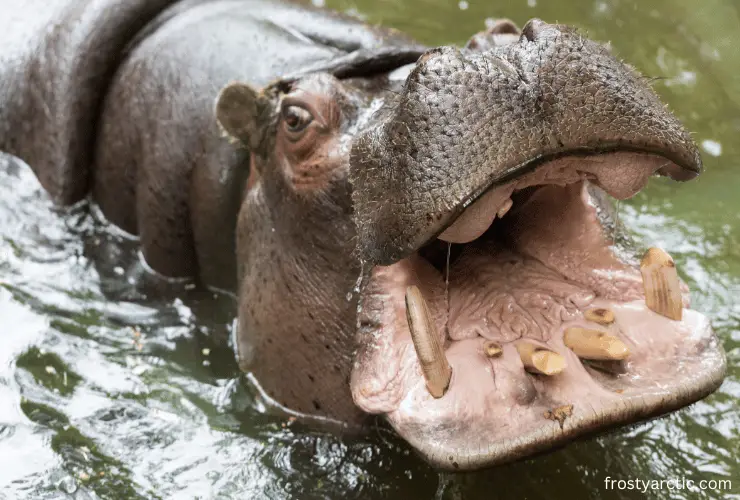
- Mating Season: Hippos do not have a specific mating season; mating can occur anytime during the year.
- Sexual Maturity: Female hippos get sexually mature at 5-6 years. Males become mature at 7 years on average.
- Gestation Period: Hippos have a longer gestation period of about 8 months.
- Calves: Females typically give birth to a single calf. The mother leaves the group to give birth and returns with the calf after a few weeks. Young hippos are weaned at around 18 months.
- Lifespan: In the wild,hippos generally live for about 40-50 years. ~Source
| Attribute | Polar Bear | Hippo |
| Mating Season | March to May | Anytime during the year |
| Sexual Maturity | Females: 3-6 years; Males: 4-5 years | Females: 5-6 years; Males: 7 years |
| Gestation Period | 195-265 days (delayed implantation) | About 8 months |
| Offspring | 1-3 cubs, stay with mother for about 2.5 years | Usually, one calf weaned at around 18 months |
| Lifespan | 15-18 years, some up to 25 years | 40-50 years |
7. Natural Predators
Although polar bears and hippos are top-tier animals in their respective ecosystems, they aren’t completely without threats. However, these threats aren’t numerous because of their size and strength.
Polar Bear
Adult polar bears have no natural predators besides their own species. Young polar bears, particularly the cubs, are often more at risk and can become the target of other predators, including their own species. This usually happens when food becomes hard to come by.
Moreover, as outlined in a COSEWIC report, these cubs could be endangered by other Arctic residents, such as foxes and wolves, when left unsupervised.
Hippo
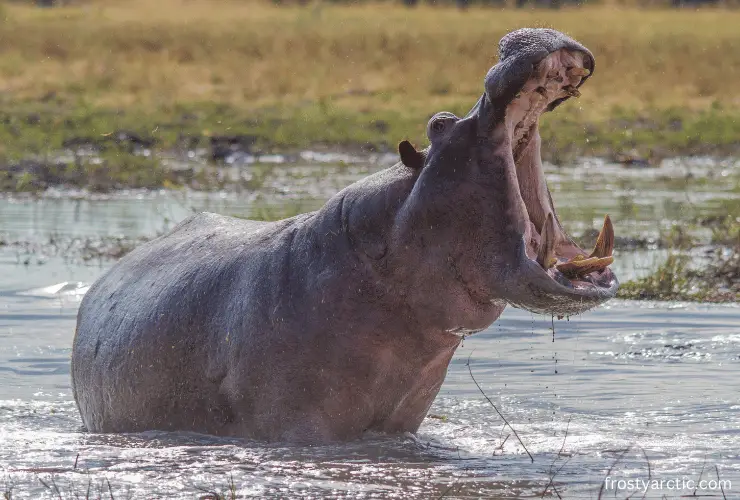
Adult hippos have very few predators, mostly due to their size, aggressive nature, and thick skin. However, young and weak hippos can fall prey to lions, hyenas, and Nile crocodiles.
| Attribute | Polar Bear | Hippo |
| Natural Predators | Other polar bears, foxes, and wolves, mainly for young cubs. | Lions, hyenas, and Nile crocodiles, mainly for young or weak hippos |
8. Defense Mechanism
Polar bears and hippos have various defensive mechanisms to protect themselves and their offspring in their respective habitats.
Polar Bear
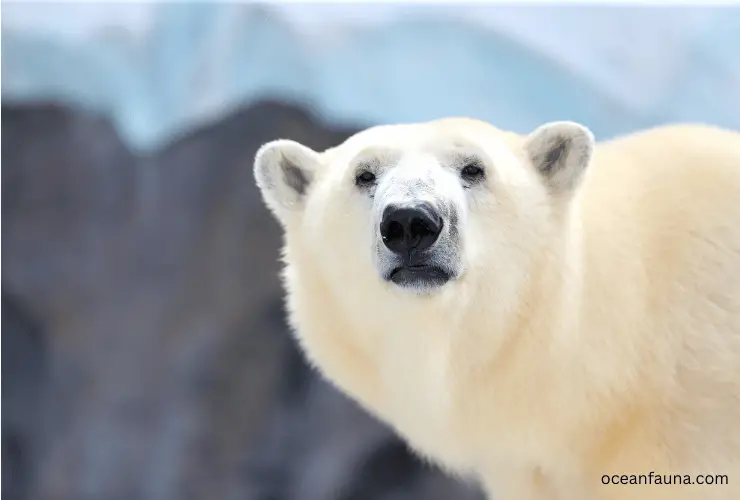
The polar bear is an apex predator with several defense mechanisms to help it survive in the harsh Arctic environment:
- Size and Strength: The size and strength of a white bear are its primary defense mechanisms. Adult polar bears are very large, strong, and fast runners, which can deter potential threats.
- Camouflage: The white fur of a polar bear acts as an excellent camouflage in the snowy and icy Arctic landscape, helping it avoid detection.
- Sharp Claws and Teeth: Polar bears have sharp claws and teeth, which they can use in fights or for self-defense.
Hippo
In contrast, the hippo, despite being herbivorous, is considered one of the most dangerous animals in Africa due to its aggressive nature and powerful defense mechanisms:
- Size and Strength: Hippos are enormous and have thick skin that provides good defense against potential predators.
- Mouth and Teeth: Hippos have large mouths and long, sharp canines and incisors, which they use for defense. Their bite can exert a massive force, enough to crush a small boat.
- Aggression: Hippos are highly territorial and aggressive, especially if a female’s calf is threatened. They won’t hesitate to charge at perceived threats.
| Attribute | Polar Bear | Hippo |
| Size and Strength | Large, strong, and fast | Large with thick skin |
| Camouflage | White fur blends into the Arctic landscape | N/A |
| Weapons | Sharp claws and teeth | A large mouth, long and sharp teeth |
| Aggression | N/A | Highly aggressive and territorial |
9. Interaction With Humans
Polar bears and hippos interact differently with humans.
Polar Bear
- Contact with Humans: Polar bear interactions with humans are relatively rare due to the remote, harsh, and sparsely populated Arctic environment in which they live. However, they are sometimes spotted near human settlements, especially as changing climate conditions alter their natural hunting grounds.
- Threat Perception: If a polar bear feels threatened, it can harm humans. This is usually rare and often occurs if a bear is surprised or protecting its young.
Hippo
In contrast, hippos have a different pattern of interaction with humans:
- Contact with Humans: Hippos frequently come into contact with humans, as they often live near bodies of water close to human settlements. They venture onto land to graze at night, sometimes moving into agricultural areas, leading to human-wildlife conflict.
- Threat Perception: Hippos are considered one of the most dangerous mammals in Africa and are responsible for an estimated 500-3,000 deaths annually. They can be extremely aggressive, especially if they feel their water access is threatened or their young are in danger. ~BBC News
| Attribute | Polar Bear | Hippo |
| Contact with Humans | Relatively rare due to remote habitats | Frequent, as they often live near human settlements |
| Threat Perception | Can be dangerous if surprised or defending young | Considered one of the most dangerous mammals in Africa |
10. Threats and Conservation Status
Polar bears and hippos face different threats.
Polar Bear
- Threats: Climate change is the most significant threat to polar bears. It reduces the sea ice they rely on for hunting seals. Other threats include oil extraction and shipping activities in the Arctic, pollution, and to a lesser extent, hunting.
- Conservation Status: The IUCN categorized the polar bear as vulnerable.
Hippo
- Threats: The primary threats to hippos are habitat loss due to agriculture and human infrastructure development, illegal hunting for their ivory and meat, and, sometimes, outbreaks of anthrax and other diseases.
- Conservation Status: The IUCN lists the common hippopotamus as vulnerable.
| Attribute | Polar Bear | Hippo |
| Major Threats | Climate change, oil extraction, hunting | Habitat loss, illegal hunting, diseases |
| Conservation Status | Vulnerable | Vulnerable |
11. Polar Bear vs Hippo: Who Would Win in a Fight?
Who would win if there’s a fight between nature’s most massive creatures: the hippopotamus and the polar bear? Let’s find out:
- Size and Weight: Hippos are bigger and heavier than polar bears, making them stronger opponents.
- Speed: Polar bears are faster both on land and in water, but not by much. Polar bears can sprint at an astonishing 40 km/hour on land and swim at a 9 km/hour pace. However, hippos are no less. They can run at 30 km/hour on land and swim at 8 km/hour.
- Bite Force: Hippos have the strongest bite among all land animals at 1800 PSI, compared to the polar bear’s 1200 PSI.
- Teeth: Hippos’ 36 sharp teeth, including 1.5 ft long canines, outdo polar bears’ 42 teeth with 5 cm long canines.
- Defense: The hippo’s thick skin, aggressive nature, and long canines offer better defense than the polar bear’s fur and freezing water swimming ability.
So, though the polar bear is a formidable predator, the odds are in favor of the hippo. The hippo’s larger size, stronger bite, and better defenses make it the more likely victor in this battle. The polar bear’s speed and claws may not be enough to overcome the hippo’s defenses.
Watch this video:
Wrapping Up
So, are polar bears and hippos the same? Far from it! While impressive in size and strength, these two magnificent creatures vastly differ in their lifestyles and adaptations.
Polar bears have evolved to adapt to life in one of the harshest environments on Earth, developing specialized characteristics like their thick fur and large, paddle-like paws.
On the other hand, with their semi-aquatic lifestyle and social habits, hippos are perfectly suited to their warm, freshwater habitats, boasting adaptations such as nearly hairless skin and powerful jaws.
We hope this blog has cleared your doubts between polar bears and hippos. The animal kingdom is chock-full of wonder and curiosity waiting to be discovered. So don’t hesitate to dive back in for more enlightening comparisons!

